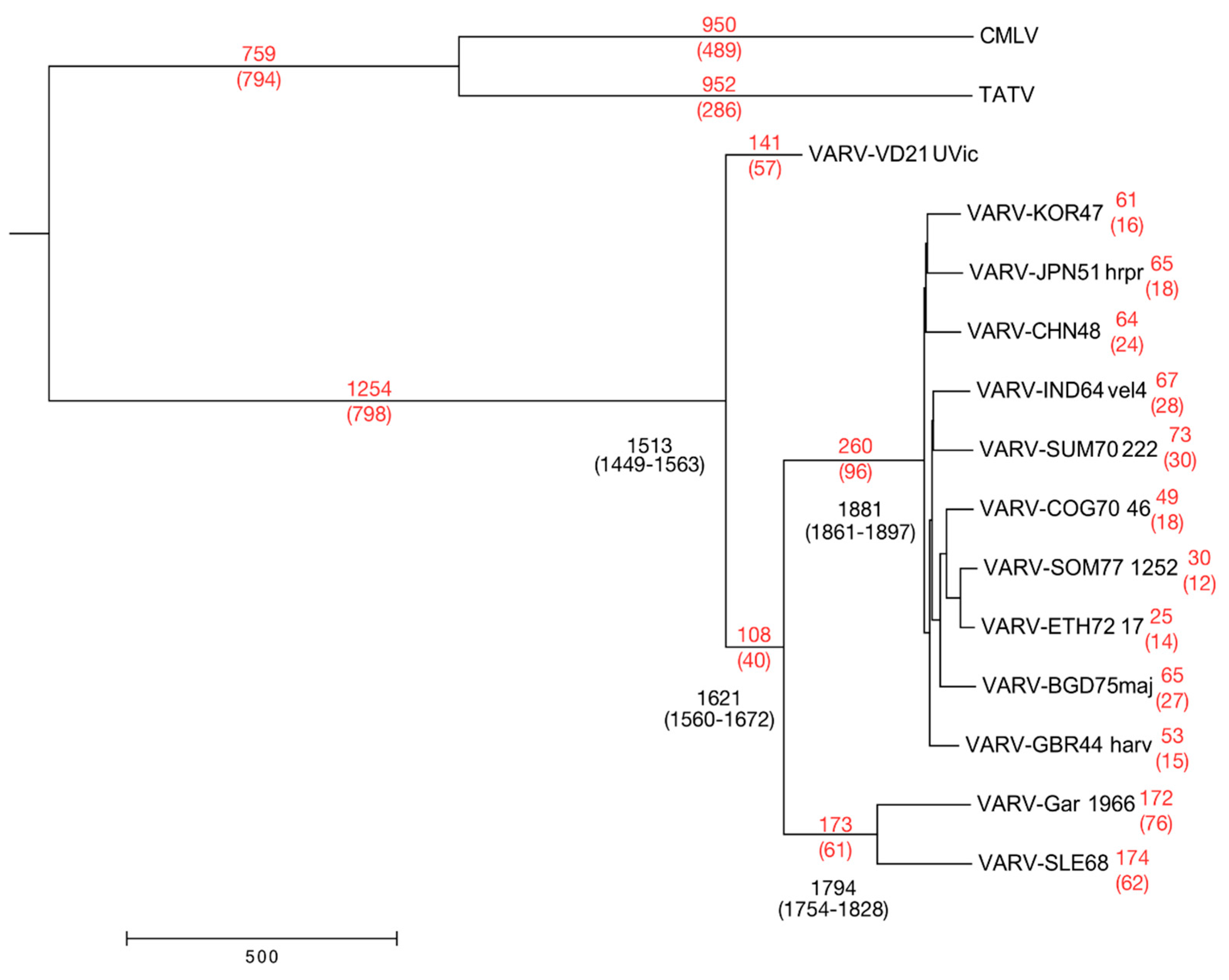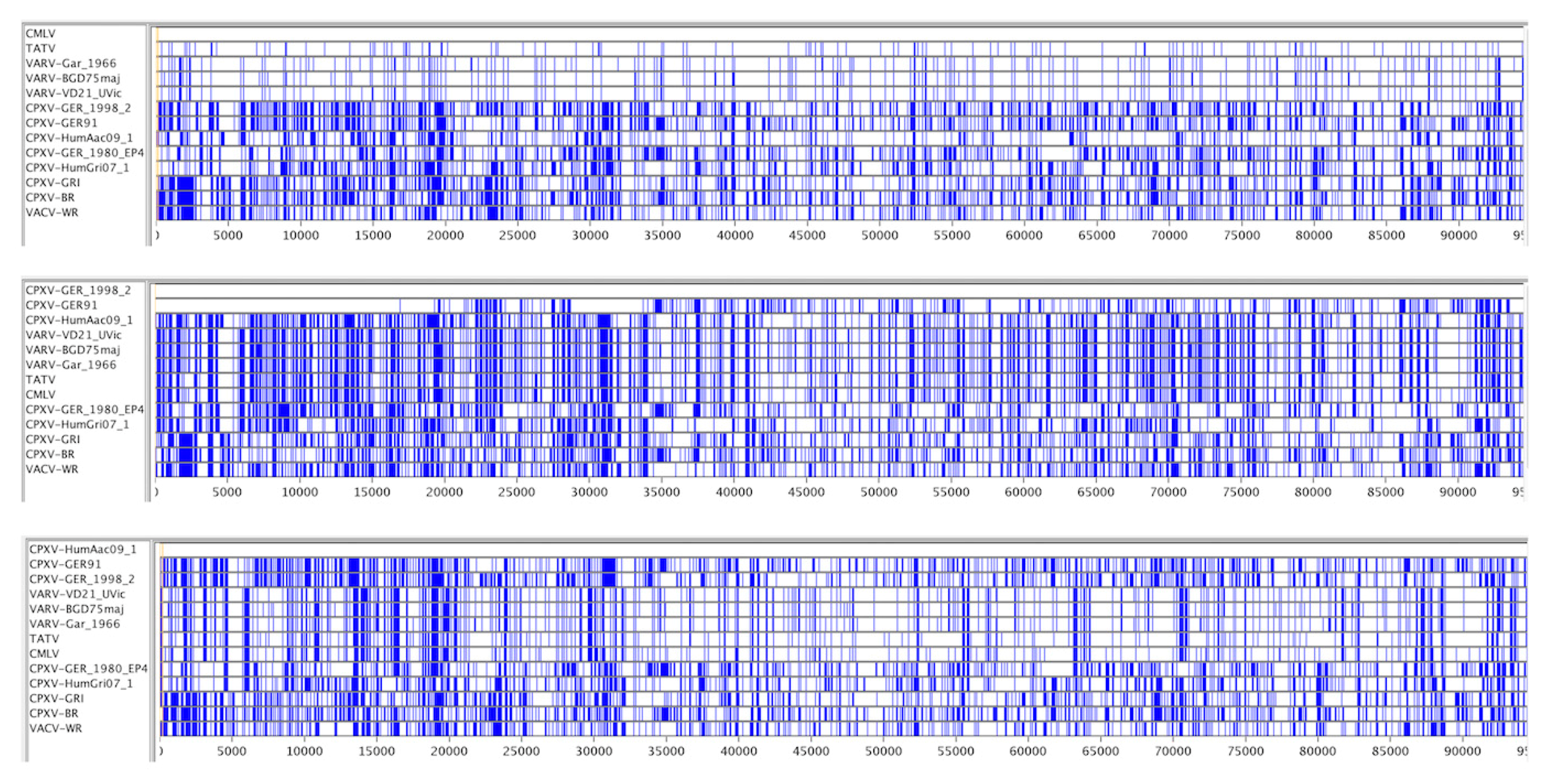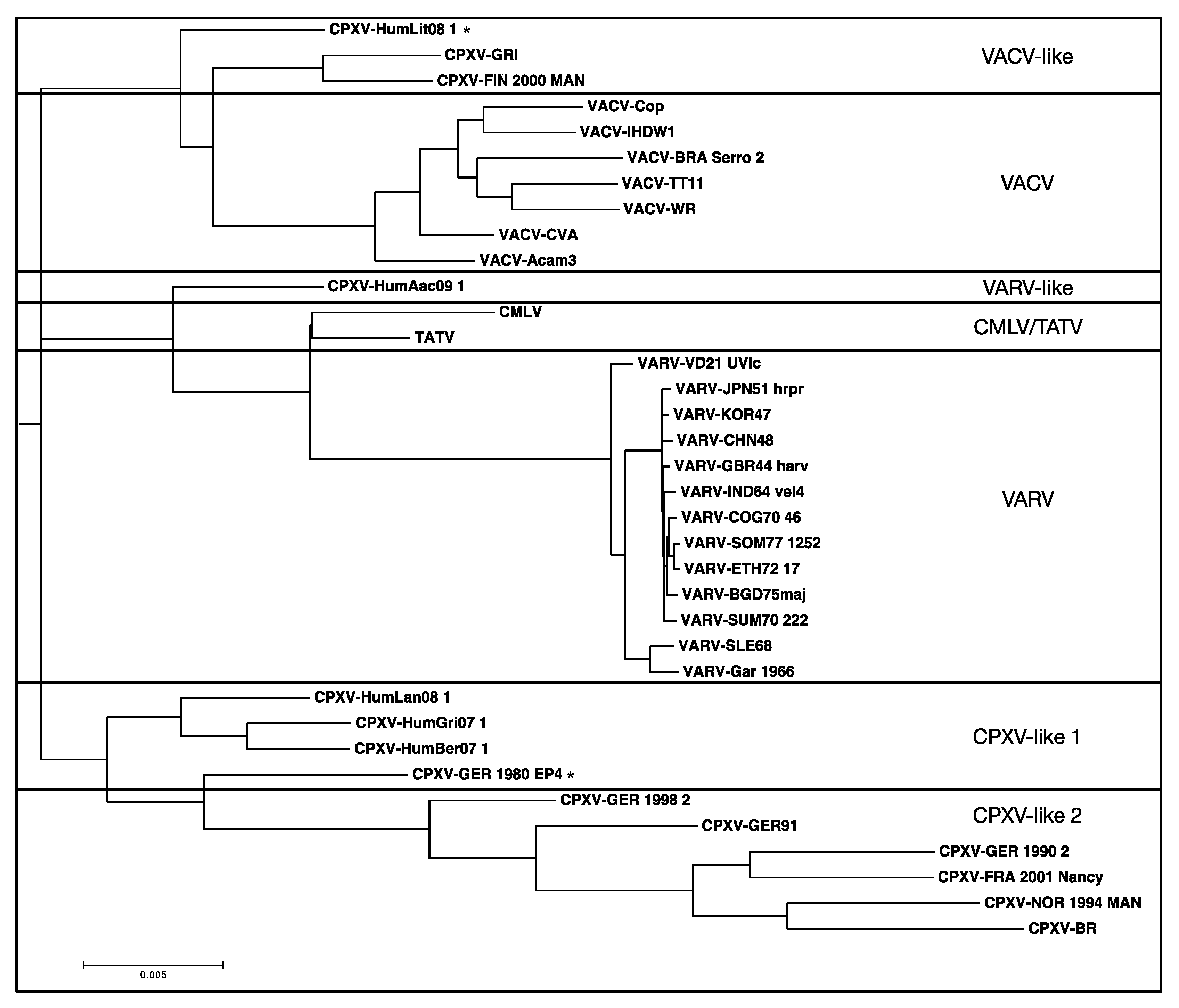Re-Assembly and Analysis of an Ancient Variola Virus Genome
Abstract
:1. Introduction
2. Materials and Methods
2.1. Retrieval of Genome Sequences and Alignment
2.2. Visual Examination of the MSA
2.3. Phylogenetic Tree Construction and Evolutionary Analyses
3. Results
3.1. Re-Assembly of the VARV-VD21 Genome
3.2. Phylogenetic History of VARV
3.3. Drift in Nucleotide Composition
3.4. Evolution of the VARV Ortholog of VACV-Cop-O1L
4. Discussion
5. Conclusions
Supplementary Materials
Acknowledgments
Author Contributions
Conflicts of Interest
References
- Duggan, A.T.; Perdomo, M.F.; Piombino-Mascali, D.; Marciniak, S.; Poinar, D.; Emery, M.V.; Buchmann, J.P.; Duchêne, S.; Jankauskas, R.; Humphreys, M.; et al. 17th century variola virus reveals the recent history of smallpox. Curr. Biol. 2016, 26, 3407–3412. [Google Scholar] [CrossRef] [PubMed]
- Jacobs, B.L.; Langland, J.O.; Kibler, K.V.; Denzler, K.L.; White, S.D.; Holechek, S.A.; Wong, S.; Huynh, T.; Baskin, C.R. Vaccinia virus vaccines: Past, present and future. Antivir. Res. 2009, 84, 1–13. [Google Scholar] [CrossRef] [PubMed]
- Sánchez-Sampedro, L.; Perdiguero, B.; Mejías-Pérez, E.; García-Arriaza, J.; di Pilato, M.; Esteban, M. The evolution of poxvirus vaccines. Viruses 2015, 7, 1726–1803. [Google Scholar] [CrossRef] [PubMed]
- Thèves, C.; Crubézy, E.; Biagini, P. History of smallpox and its spread in human populations. Microbiol. Spectr. 2016, 4, 161–172. [Google Scholar]
- McCollum, A.M.; Damon, I.K. Human monkeypox. Clin. Infect. Dis. 2014, 58, 260–267. [Google Scholar] [CrossRef] [PubMed]
- Esteban, D.J.; Buller, R.M.L. Ectromelia virus: The causative agent of mousepox. J. Gen. Virol. 2005, 86, 2645–2659. [Google Scholar] [CrossRef] [PubMed]
- Nalca, A.; Nichols, D.K. Rabbitpox: A model of airborne transmission of smallpox. J. Gen. Virol. 2011, 92, 31–35. [Google Scholar] [CrossRef] [PubMed]
- Li, G.; Chen, N.; Roper, R.L.; Feng, Z.; Hunter, A.; Danila, M.I.; Lefkowitz, E.J.; Buller, R.M.L.; Upton, C. Complete coding sequences of the rabbitpox virus genome. J. Gen. Virol. 2005, 86, 2969–2977. [Google Scholar] [CrossRef] [PubMed]
- Franke, A.; Pfaff, F.; Jenckel, M.; Hoffmann, B.; Höper, D.; Antwerpen, M.; Meyer, H.; Beer, M.; Hoffmann, D. Classification of cowpox viruses into several distinct clades and identification of a novel lineage. Viruses 2017, 9, 142. [Google Scholar] [CrossRef] [PubMed]
- Mauldin, M.; Antwerpen, M.; Emerson, G.; Li, Y.; Zoeller, G.; Carroll, D.; Meyer, H. Cowpox virus: What’s in a name? Viruses 2017, 9, 101. [Google Scholar] [CrossRef] [PubMed]
- Dabrowski, P.W.; Radonić, A.; Kurth, A.; Nitsche, A. Genome-wide comparison of cowpox viruses reveals a new clade related to variola virus. PLoS ONE 2013, 8, e79953. [Google Scholar] [CrossRef] [PubMed]
- Tu, S.-L.; Nakazawa, Y.; Gao, J.; Wilkins, K.; Gallardo-Romero, N.; Li, Y.; Emerson, G.L.; Carroll, D.S.; Upton, C. Characterization of eptesipoxvirus, a novel poxvirus from a microchiropteran bat. Virus Genes 2017, 161, 1–12. [Google Scholar] [CrossRef] [PubMed]
- Gershon, P.D.; Kitching, R.P.; Hammond, J.M.; Black, D.N. Poxvirus genetic recombination during natural virus transmission. J. Gen. Virol. 1989, 70, 485–489. [Google Scholar] [CrossRef] [PubMed]
- Qin, L.; Evans, D.H. Genome scale patterns of recombination between co-infecting vaccinia viruses. J. Virol. 2014, 88, 5277–5286. [Google Scholar] [CrossRef] [PubMed]
- Smithson, C.; Kampman, S.; Hetman, B.; Upton, C. Incongruencies in vaccinia virus phylogenetic trees. Computation 2014, 2, 182–198. [Google Scholar] [CrossRef]
- Smithson, C.; Purdy, A.; Verster, A.J.; Upton, C. Prediction of steps in the evolution of variola virus host range. PLoS ONE 2014, 9, e91520. [Google Scholar] [CrossRef] [PubMed]
- Kazutaka, K.; Standley, D.M. MAFFT multiple sequence alignment software version 7: Improvements in performance and usability. Mol. Biol. Evol. 2013, 30, 772–780. [Google Scholar]
- Hillary, W.; Lin, S.-H.; Upton, C. Base-by-base version 2: Single nucleotide-level analysis of whole viral genome alignments. Microb. Inform. Exp. 2011, 1, 2. [Google Scholar] [CrossRef] [PubMed]
- Stamatakis, A. RAxML version 8: A tool for phylogenetic analysis and post-analysis of large phylogenies. Bioinformatics 2014, 30, 1312–1313. [Google Scholar] [CrossRef] [PubMed]
- Bouckaert, R.; Heled, J.; Kühnert, D.; Vaughan, T.; Wu, C.-H.; Xie, D.; Suchard, M.A.; Rambaut, A.; Drummond, A.J. BEAST 2: A software platform for Bayesian evolutionary analysis. PLoS Comput. Biol. 2014, 10, e1003537. [Google Scholar] [CrossRef] [PubMed]
- Pajer, P.; Dresler, J.; Kabíckova, H.; Písa, L.; Aganov, P.; Fucik, K.; Elleder, D.; Hron, T.; Kuzelka, V.; Velemínsky, P.; et al. Characterization of two historic smallpox specimens from a Czech museum. Viruses 2017, 9, 200. [Google Scholar] [CrossRef] [PubMed]
- Martin, M. Cutadapt removes adapter sequences from high-throughput sequencing reads. EMBnet. J. 2011, 17, 10–12. [Google Scholar] [CrossRef]
- Chevreux, B.; Pfisterer, T.; Drescher, B.; Driesel, A.J.; Müller, W.E.G.; Wetter, T.; Suhai, S. Using the miraEST assembler for reliable and automated mRNA transcript assembly and SNP detection in sequenced ESTs. Genome Res. 2004, 14, 1147–1159. [Google Scholar] [CrossRef] [PubMed]
- Bankevich, A.; Nurk, S.; Antipov, D.; Gurevich, A.A.; Dvorkin, M.; Kulikov, A.S.; Lesin, V.M.; Nikolenko, S.I.; Pham, S.; Prjibelski, A.D.; et al. SPAdes: A new genome assembly algorithm and its applications to single-cell sequencing. J. Comput. Biol. 2012, 19, 455–477. [Google Scholar] [CrossRef] [PubMed]
- Milne, I.; Stephen, G.; Bayer, M.; Cock, P.J.A.; Pritchard, L.; Cardle, L.; Shaw, P.D.; Marshall, D. Using tablet for visual exploration of second-generation sequencing data. Brief. Bioinform. 2013, 14, 193–202. [Google Scholar] [CrossRef] [PubMed]
- Li, Y.; Carroll, D.S.; Gardner, S.N.; Walsh, M.C.; Vitalis, E.A.; Damon, I.K. On the origin of smallpox: Correlating variola phylogenics with historical smallpox records. Proc. Natl. Acad. Sci. USA 2007, 104, 15787–15792. [Google Scholar] [CrossRef] [PubMed]
- Schweneker, M.; Lukassen, S.; Späth, M.; Wolferstätter, M.; Babel, E.; Brinkmann, K.; Wielert, U.; Chaplin, P.; Suter, M.; Hausmann, J. The vaccinia virus O1 protein is required for sustained activation of extracellular signal-regulated kinase 1/2 and promotes viral virulence. J. Virol. 2012, 86, 2323–2336. [Google Scholar] [CrossRef] [PubMed]
- Bonjardim, C.A. Viral exploitation of the MEK/ERK pathway—A tale of vaccinia virus and other viruses. Virology 2017, 507, 267–275. [Google Scholar] [CrossRef] [PubMed]
- Martin, D.P.; Murrell, B.; Golden, M.; Khoosal, A.; Muhire, B. RDP4: Detection and analysis of recombination patterns in virus genomes. Virus Evol. 2015, 1, vev003. [Google Scholar] [CrossRef] [PubMed]
- Senkevich, T.G.; Koonin, E.V.; Bugert, J.J.; Darai, G.; Moss, B. The genome of molluscum contagiosum virus: Analysis and comparison with other poxviruses. Virology 1997, 233, 19–42. [Google Scholar] [CrossRef] [PubMed]
- Lakis, N.S.; Li, Y.; Abraham, J.L.; Upton, C.; Blair, D.C.; Smith, S.; Zhao, H.; Damon, I.K. Novel poxvirus infection in an immune suppressed patient. Clin. Infect. Dis. 2015, 61, 1543–1548. [Google Scholar] [CrossRef] [PubMed]
- Miranda, J.B.; Borges, I.A.; Campos, S.P.S.; Vieira, F.N.; de Ázara, T.M.F.; Marques, F.A.; Costa, G.B.; Luis, A.P.M.F.; de Oliveira, J.S.; Ferreira, P.C.P.; et al. Serologic and molecular evidence of vaccinia virus circulation among small mammals from different biomes, Brazil. Emerg. Infect. Dis. 2017, 23, 931–938. [Google Scholar] [CrossRef] [PubMed]
- Fleming, S.; Wise, L.; Mercer, A. Molecular genetic analysis of orf virus: A poxvirus that has adapted to skin. Viruses 2015, 7, 1505–1539. [Google Scholar] [CrossRef] [PubMed]
- Springer, Y.P.; Hsu, C.H.; Werle, Z.R.; Olson, L.E.; Cooper, M.P.; Castrodale, L.J.; Fowler, N.; McCollum, A.M.; Goldsmith, C.S.; Emerson, G.L.; et al. Novel orthopoxvirus infection in an Alaska resident. Clin. Infect. Dis. 2017, 64, 1737–1741. [Google Scholar] [CrossRef] [PubMed]
- Sawyer, S.L.; Elde, N.C. A cross-species view on viruses. Curr. Opin. Virol. 2012, 2, 561–568. [Google Scholar] [CrossRef] [PubMed]
- Vellozzi, C.; Lane, J.M.; Averhoff, F.; Maurer, T.; Norton, S.; Damon, I.; Casey, C. Generalized vaccinia, progressive vaccinia, and eczema vaccinatum are rare following smallpox (vaccinia) vaccination: United States surveillance, 2003. Clin. Infect. Dis. 2005, 41, 689–697. [Google Scholar] [CrossRef] [PubMed]
- Roy Choudhury, S.; Pan, A.; Mukherjee, D. Genus specific evolution of codon usage and nucleotide compositional traits of poxviruses. Virus Genes 2011, 42, 189–199. [Google Scholar] [CrossRef] [PubMed]
- Da Silva, M.; Upton, C. Using purine skews to predict genes in AT-rich poxviruses. BMC Genom. 2005, 6, 22. [Google Scholar] [CrossRef] [PubMed] [Green Version]
- Da Silva, M.; Upton, C. Host-derived pathogenicity islands in poxviruses. Virol. J. 2005, 2, 30. [Google Scholar] [CrossRef] [PubMed] [Green Version]
- Monier, A.; Claverie, J.-M.; Ogata, H. Horizontal gene transfer and nucleotide compositional anomaly in large DNA viruses. BMC Genom. 2007, 8, 456. [Google Scholar] [CrossRef] [PubMed]
- Gammon, D.B.; Gowrishankar, B.; Duraffour, S.; Andrei, G.; Upton, C.; Evans, D.H. Vaccinia virus-encoded ribonucleotide reductase subunits are differentially required for replication and pathogenesis. PLoS Pathog. 2010, 6, e1000984. [Google Scholar] [CrossRef] [PubMed]
- Mo, M.; Fleming, S.B.; Mercer, A.A. Orf virus cell cycle regulator, PACR, competes with subunit 11 of the anaphase promoting complex for incorporation into the complex. J. Gen. Virol. 2010, 91, 3010–3015. [Google Scholar] [CrossRef] [PubMed]








| Species | Strain Name | Year | Country | Host | Accession |
|---|---|---|---|---|---|
| CMLV | CMLV-CMS | 1970 | Iran | Dromedary | AY009089 |
| CPXV (CPXV-like 1) | CPXV-GER_1980_EP4 | 1980 | Germany | Elephant | HQ420895 |
| CPXV (CPXV-like 1) | CPXV-HumBer07/1 | 2007 | Germany | Human | KC813509 |
| CPXV (CPXV-like 1) | CPXV-HumGri07/1 | 2007 | Germany | Human | KC813511 |
| CPXV (CPXV-like 1) | CPXV-HumLan08/1 | 2008 | Germany | Human | KC813492 |
| CPXV (CPXV-like 2) | CPXV-BR | 1939 | UK | Human | NC_003663 |
| CPXV (CPXV-like 2) | CPXV-FRA_2001_Nancy | 2001 | France | Human | HQ420894 |
| CPXV (CPXV-like 2) | CPXV-GER_1990_2 | 1990 | Germany | Human | HQ420896 |
| CPXV (CPXV-like 2) | CPXV-GER91 | 1991 | Germany | Human | DQ437593 |
| CPXV (CPXV-like 2) | CPXV-NOR_1994_MAN | 1994 | Norway | Human | HQ420899 |
| CPXV (Unassigned) | CPXV-GER_1998_2 | 1998 | Germany | Human | HQ420897 |
| CPXV (Unassigned) | CPXV-HumLit08/1 | 2008 | Germany | Human | KC813493 |
| CPXV (VACV-like) | CPXV-FIN_2000_MAN | 2000 | Finland | Human | HQ420893 |
| CPXV (VACV-like) | CPXV-GRI | 1990 | Russia | Human | X94355 |
| CPXV (VARV-like) | CPXV-HumAac09/1 | 2009 | Germany | Human | KC813508 |
| ECTV | ECTV-Mos | 1947 | Russia | Mouse | NC_004105 |
| TATV | TATV-DAH68 | 1968 | Benin | Gerbil | NC_008291 |
| VACV | VACV-Acam3 | 2003 | US | Unknown | AY313848 |
| VACV | VACV-BRA_Serro | 2005 | Brazil | Unknown | KF179385 |
| VACV | VACV-Cop | 1990 | US | Unknown | M35027 |
| VACV | VACV-CVA | 2007 | Germany | Unknown | AM501482 |
| VACV | VACV-IHDW1 | 2013 | Canada | Unknown | KJ125439 |
| VACV | VACV-TT1 | 2012 | China | Unknown | JX489138 |
| VACV | VACV-WR | 1982 | US | Unknown | NC_006998 |
| VARV | VARV-VD21 | 2011 | Lithuania | Human | KY358055 |
| VARV (major) | VARV-V563 | 1954 | Czech Republic | Human | LT706528 |
| VARV (major) | VARV-BGD75maj | 1975 | Bangladesh | Human | L22579 |
| VARV (major) | VARV-CHN48 | 1948 | China | Human | DQ437582 |
| VARV (major) | VARV-COG70_46 | 1970 | Congo | Human | DQ437583 |
| VARV (major) | VARV-ETH72_17 | 1972 | Ethiopia | Human | DQ441425 |
| VARV (major) | VARV-GBR44_harv | 1944 | UK | Human | DQ441444 |
| VARV (major) | VARV-IND64_vel4 | 1964 | India | Human | DQ437585 |
| VARV (major) | VARV-JPN51_hrpr | 1951 | Japan | Human | DQ441430 |
| VARV (major) | VARV-KOR47 | 1947 | Korea | Human | DQ441432 |
| VARV (major) | VARV-SOM77_1252 | 1977 | Somalia | Human | DQ441438 |
| VARV (major) | VARV-SUM70_222 | 1970 | Sumatra | Human | DQ437591 |
| VARV (major) | VARV-India 1967 | 1967 | India | Human | NC_001611 |
| VARV (minor) | VARV-V1588 | 1849 | Czech Republic | Human | LT706529 |
| VARV (minor) | VARV-SLE68 | 1969 | Sierra Leone | Human | DQ441437 |
| VARV (minor) | VARV-Gar_1966 | 1966 | Brazil | Human | X72086 |
| Starting nt in VARV VD21-Uvic | New nt in Modern Sequence | Major (BGD75maj) | Minor (Gar_1966) |
|---|---|---|---|
| A | C | 2 | 1 |
| G | 35 | 41 | |
| T | 3 | 5 | |
| C | A | 9 | 9 |
| G | 0 | 2 | |
| T | 78 | 70 | |
| G | A | 66 | 64 |
| C | 1 | 2 | |
| T | 4 | 5 | |
| T | A | 8 | 6 |
| C | 36 | 45 | |
| G | 6 | 2 | |
| Total # SNPs | 248 | 252 | |
| SNPs that increase A + T% | 157 | 148 | |
| SNPs that increase G + C% | 79 | 89 | |
| Ancestral | New nt in CMLV Sequence | CMLV |
|---|---|---|
| A | C | 9 |
| G | 35 | |
| T | 12 | |
| C | A | 54 |
| G | 5 | |
| T | 126 | |
| G | A | 107 |
| C | 7 | |
| T | 52 | |
| T | A | 11 |
| C | 27 | |
| G | 12 | |
| Total # SNPs | 457 | |
| SNPs that increase A + T% | 339 | |
| SNPs that increase G + C% | 83 | |
© 2017 by the authors. Licensee MDPI, Basel, Switzerland. This article is an open access article distributed under the terms and conditions of the Creative Commons Attribution (CC BY) license (http://creativecommons.org/licenses/by/4.0/).
Share and Cite
Smithson, C.; Imbery, J.; Upton, C. Re-Assembly and Analysis of an Ancient Variola Virus Genome. Viruses 2017, 9, 253. https://doi.org/10.3390/v9090253
Smithson C, Imbery J, Upton C. Re-Assembly and Analysis of an Ancient Variola Virus Genome. Viruses. 2017; 9(9):253. https://doi.org/10.3390/v9090253
Chicago/Turabian StyleSmithson, Chad, Jacob Imbery, and Chris Upton. 2017. "Re-Assembly and Analysis of an Ancient Variola Virus Genome" Viruses 9, no. 9: 253. https://doi.org/10.3390/v9090253





